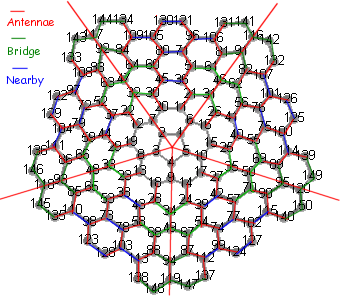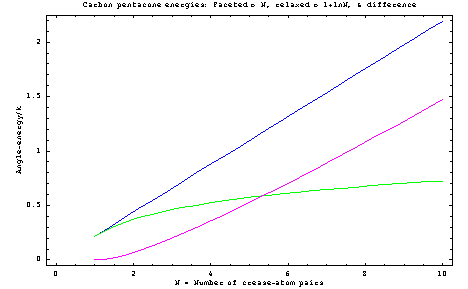
Below find a pentagon-based carbon nanocone with 35 atoms. Isn't it amazing how a single pentagon causes what would otherwise be a flat hexagonal network to fold up into the shape of a 5-sided umbrella? Play with it a bit to find out what angles between edge-on sheets show up in projection?
Do these faceted structures sometimes occur in nature? Possibly. For example, how do the angles seen in edge-on projection above compare to the angles between line segments in this image of strange unlayered-graphene found in soot particles condensed in the atmosphere of red giant stars, long before the formation of the solar system we live in today?

Read more about this stuff here. High-resolution electron microscope images with contrast proportional to projected-potential are sensitive to the amount of faceting in carbon nanocones. Faceting might guage the extent to which nanocone walls have retained polygonal cross-sections, as might be expected if formed by a bulk process like the dendritic crystallization of atom-thick sheets. For example droplet-solidification after laser ablation has been implicated in formation of high-purity single-walled nanohorns in laboratories on earth, although carbon nanohorns (e.g. with several apex pentagons) have much smaller cone-angles than pentagonal nanocones. Additional diffraction and hi-res electron studies, with both data acquisition and modeling of unlayered-graphene from the core of micron-sized interstellar graphite onions, are therefore in the works.
Here's a larger 5-sided umbrella: This allows you to double-click on each of two atoms to label the distance between them, to double/single/double click on three atoms to label the angle spanned at center atom by the triplet, and to double/single/single/double click on four atoms to label the dihedral angle between the two planes defined thereby.
Yikes! This particular model's growth process is going awry. Can you figure out which atoms are already in bogus locations?
Faceted growth might proceed by repeated application of the following growth loop: {antenna-growth (red), bridge-formation (green), antenna-growth (red), connect-nearby (blue)}, etc. Starting with a five-hexagon pentagonal seed (gray), this process proceeds as shown in the figure below to give arbitrarily-large faceted pentacones. The radial red lines denote the creases between facets. The growth strategy seems reasonably robust, at least in that starting with a six-hexagon flat seed results in an increasingly larger flat sheet instead.

These differ from non-faceted pentacones generated by Steffen Weber's applet, which instead rolls up a "flexible hex-grid sheet" after a 60-degree pie slice has been removed. Weber's approach thus results in smaller interatom distances near regions of high sheet-curvature (i.e. the center), and of course no faceting at all.
To see what unlayered graphene grown from randomly-oriented seeds of this type might look like, check out the "grown graphene" model at this http URL.
Finding the energy of facet-relaxation is another challenge. For example, presume that graphene sheets like to be flat and evaluate the first term in a Taylor expansion about the "flatness potential" minimum. This yields an angle-energy for the ith bond angle of Ei = (1/2)k{bondanglei-(2Pi/3)}2. In a faceted nanocone this energy is zero for all except the crease atoms, which have two 120o bonds (no energy) and one 108o bond. By counting all bond angles, it then follows that Efacet = Nk(Pi2/45), where N is the number of crease-atom pairs in line radially outward from nanocone center to edge. For example, the model above has three crease-atom pairs along each spoke, so that N=3.
After relaxation, we estimate (going to the continuum limit with a N/N2 integral) that the total angle-energy will decrease to Erelaxed ~ (1+lnN)k(Pi2/45). This gives a faceting energy (relative to relaxed) of Extra ~ k(Pi2/45)Xi[N]. Here Xi[N], defined as N-1-lnN, is a widely useful function for measuring availabilities (i.e. free energies and net surprisals) relative to ambient. These bond-angle energies are plotted below (Efacet in blue, Erelaxed in green, and Extra in magenta) as a function of the number of "crease atom" pairs N running radially outward. Any suggestions on estimating the effective order-of-magnitude size for k, e.g. by experimentally or theoretically comparing two bond-equal configurations with differing flatness?

One way to get an order-of-magnitude for k might be to determine energy differences per atom (sans edge effects) for a flat sheet, a zig-zag nanotube, and an arm-chair nanotube. A k-value for zig-zag and arm-chair bending, relative to flat, might then be calculated. Since nanocone bending (as you can see from the labeled model above) ranges from zig-zag to armchair, the average between these two k-values might provide a reasonable estimate. A literature reference suggesting 0.2 eV/atom difference for a zig-zag (10,0) nanotube, for example, would drop k near 200 eV/radian^2. Alternatively, one might assume that the 0.7 eV/atom difference* in energy between C60 and graphite is largely due to bending. This suggests k around 32[eV/radian^2], but ignores proximate atom resonances which could be significant for this tightly curved fullerene. Of course, whether the energy liberated by relaxation is larger or smaller than kT, we are unlikely to find faceted nano-cones unless some mechanism for preventing relaxation (e.g. crowding on formation) is in place from day one.
* cf. Dresselhaus et al, Science of fullerence and carbon nanotubes (Academic Press, 1996)
Much of our experimental work of late has been on comparison of experimental powder diffraction patterns from this unlayered graphene to models. Look for more on this here shortly.